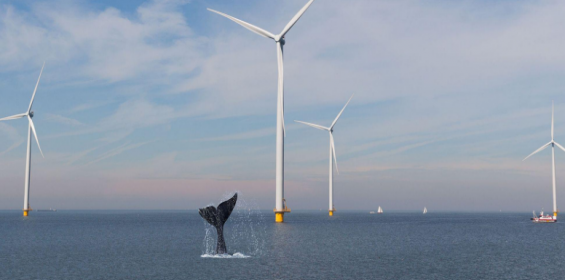Whale-protecting ocean drones accelerate offshore wind
Published: 21 September, 2022
Saildrone has announced it has been selected to receive a major award from the National Offshore Wind Research and Development Consortium (NOWRDC) to facilitate offshore wind’s coexistence with wildlife and other ocean users.
Saildrone in collaboration with RPS, a leading provider of professional services to the offshore wind industry, will utilise advanced uncrewed observing, artificial intelligence, and machine learning (ML) technologies to create a line-of-sight monitoring network to detect, classify, and localise marine mammals in areas with offshore wind developments.
The global development of offshore wind is key to moving away from traditional, non-renewable sources, especially fossil fuels. The development, production, and use of fossil fuels, a finite resource, produce carbon dioxide and other greenhouse gasses that contribute to climate change. Accelerating the production of renewable fuel sources like offshore wind can help slow climate change and reduce dependence on foreign energy sources.
While offshore wind is much better for the environment, marine mammals use sound for foraging, orientation, and communication and are therefore possibly susceptible to the negative effects of man-made noise generated from constructing and operating large offshore wind turbines.
Monitoring marine mammals who may be impacted by offshore wind development and operations has traditionally been very difficult. Saildrones USVs will provide a more effective, cost-efficient, and environmentally friendly alternative to traditional visual surveys from ships and aircraft.
“Saildrone is very excited to be working with NOWRDC to help accelerate offshore wind energy development,” said Richard Jenkins, Saildrone founder and CEO. “We have worked hard over recent years to integrate new payloads, such as seafloor mapping sonars, sub-bottom profilers, and passive acoustics, specifically to support the rapid growth of the offshore wind industry. Simultaneously protecting marine mammals while technically supporting offshore wind development with our low-carbon vehicles will be a key accelerator for the industry.”
“RPS is looking forward to using our expertise in support of this opportunity to advance cutting edge marine mammal monitoring technology with Saildrone and NOWRDC”, said Stephanie Milne, RPS Team Leader, US Offshore Renewables. “We have advanced the development of several monitoring technologies that are now widely utilised in the offshore energy industry and we are excited to be contributing to this big next step.”
The award is one of five new projects to receive a total of $3.5 million from NOWRDC to facilitate offshore wind’s coexistence with wildlife and other ocean users and support other industry initiatives.
“NOWRDC is excited to award projects that directly respond to challenges in the offshore wind industry,” said Kevin Knobloch, executive director of NOWRDC. “As we approach the deployment of commercial-scale offshore wind in the US, these projects have the potential to provide real solutions to near-term industry challenges—ranging from stakeholder coordination to transmission resiliency. The projects thus offer the opportunity to improve the state of the art in offshore wind development.”
Marine mammal monitoring isn’t the only technological advancement Saildrone is bringing to the offshore wind industry. The company provides the critical ocean data needed to support the entire life cycle of an offshore wind farm, from site assessment and development to construction and operation. Saildrone USVs, powered by renewable wind and solar energy with a minimal or zero operational carbon footprint, collect comprehensive real-time metocean data from wind monitoring to high-resolution ocean mapping, persistent year-round ecosystem monitoring, and maritime security solutions.
While every Saildrone USV can undertake multiple long missions concurrently, operating 24/7/365, increasing cost efficiencies, and accelerating renewable energy development, each vehicle class is optimized for a primary mission.
The 65-foot Saildrone Surveyor provides International Hydrographic Organisation (IHO)-compliant multibeam ocean mapping down to 23,000 feet (7,000 m) that exceeds the quality delivered by traditional methods. Wind farm developers require a detailed understanding of the ocean floor and continuous surveying for topographical shifts due to sediment redistribution by ocean currents. Ocean mapping is traditionally done by survey ships, which are expensive and difficult to book causing costly construction delays. Operating without crew, the Saildrone Surveyor can map continuously for over 180 days, delivering high-quality hydrographic information faster at a fraction of the cost of traditional survey ships.
The 23-foot Explorer delivers persistent year-round monitoring of a comprehensive set of metocean data, a task traditionally requiring fixed buoys and met towers tied to a single location, which are challenging and expensive to permit, install, and service. Unlike buoys, Saildrone Explorers do not require a permit, or installation by ship, to start collecting data across the wind energy area. Powered entirely by wind and solar with a zero carbon operating footprint, the Saildrone Explorer can remain on mission for up to 12 months, transmitting critical data back to Mission Control in real time and sailing autonomously back to base for recalibration and service.
The 33-foot Voyager carries a complete set of metocean sensors plus a sub-bottom profiler to identify and characterise layers of sediment or rock under the seafloor and is capable of IHO-compliant multibeam ocean mapping down to 984 feet (300 m). The Voyager is also optimized for wind farm security providing persistent advanced situational awareness. Saildrone’s passive acoustics, optical cameras, and advanced machine learning algorithms deliver real-time detection of anything in the vicinity of offshore wind farms, including commercial and recreational boats or other vessels that may choose not to transmit their position, as well as identifying natural visitors like whales, seabirds, and bats to support environmental impact mitigation strategies.
The impressive capabilities of Saildrone’s autonomous vehicles have been proven in numerous operational missions for science, ocean mapping, and maritime security, covering almost 1,000,000 nautical miles from the Arctic to the Antarctic. The Saildrone fleet has logged more than 20,000 days at sea in some of the most extreme weather conditions on the planet.






